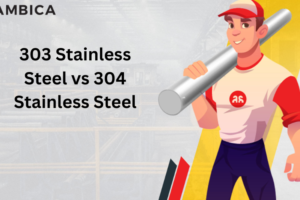Stainless Steel is truly a miracle material for various industries. The astounding properties of stainless steel make it desirable for multiple applications. Out of the many stainless steel grades available, Grade 302 and Grade 304 grab special attention. Both these grades are austenitic stainless steel alloys offering a plethora of features to suit multiple applications across varied industries.
Let’s delve into the details of how stainless steel 304 grade and stainless steel grade 302 differ.
304 vs 302 CHEMICAL COMPOSITION DIFFERENCE
Different grades of stainless steel differ in their chemical composition. This chemical composition defines their properties and is why they are them in various applications. Grade 302 and grade 304 differ slightly in their chemical composition, but resulting in a considerable difference in their properties.
Chemical composition of Grade 302:
Chromium, Cr 17-19%
Nickel, Ni 8 – 10%
Manganese, Mn 2%
Silicon, Si 1.00%
Carbon, C 0.15%
Sulfur, S 0.03%
Phosphorous, P .045%
Chemical composition of Grade 304:
Carbon, C – .08%
Manganese, Mn – 2%
Silicon, Si – .75%
Phosphorus, P – .045%
Sulfur, S – .03%
Chromium, Cr – 18-20%
Nickel, Ni – 8 – 10.5%
Nitrogen, N – .10%
304 vs 302 MECHANICAL PROPERTIES DIFFERENCE
Another important factor to consider, while discussing the differences between grade 302 and grade 304 are their mechanical properties. Here is how the two grades differ in their mechanical properties:
Corrosion Resistance:
Grade 304 has higher corrosion resistance to corrosion due to its notable chromium content, whereas grade 302 has lesser chromium content and hence is less corrosion resistant than grade 304.
Strength Values:
- Grade 302 is stronger than grade 304.
- The Minimum tensile strength of 302 is 585MPa, while for 304 is 515MPa.
- Yield strength of 302 is 240MPa, while for 304 is
- Elongation at break for 302 is higher than for 304.
Toughness:
- Having higher carbon content, grade 302 is tougher than 304.
Ductility:
- Grade 304 material is more malleable compared to grade 302.
304 vs 302 APPLICATIONS DIFFERENCE
The difference in their chemical composition and their properties results in how these two grades are used in various applications. Let us have a look at the various applications of both grade 302 and grade 304.
Some of the common applications of stainless steel grade 304 are:
- Food processing equipment for beer brewing, milk processing, and winemaking.
- Kitchen workstations, sinks, troughs, equipment, and appliances.
- Architectural panelling, beadboard, railings, and trim.
- Chemical containers, such as those used for shipment;
- Heat exchangers.
- Woven or welded screens used for mining, quarrying and water filtration.
- Threaded fasteners.
Some of the applications of Stainless Steel 302 are:
- Stamping
- Wire forming
- Spinning
- Springs, screens, cables and washers
- Pressure containing applications
- Food and beverage industry
- Sanitary or cryogenic applications
Apart from the above SS 302 also finds its application in some of the common appliances like:
- Refrigerators
- Counters
- Blenders
- Dish racks
- Dishwashers
- Washing machines
304 vs 302 COST DIFFERENCE
The cost-effectiveness of stainless steel is a major factor contributing to its usage in various applications. Commenting on the cost difference between grade 302 and grade 304, both of them have almost similar costs, with grade 304 on the slightly higher side. But the better machinability and formability of grade 304 make it a more preferred option in various industries even being higher cost. Grade 302 takes the lead in applications not requiring heavy welding or machining operations owing to its lower cost.



